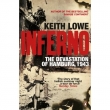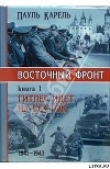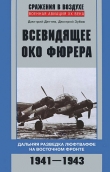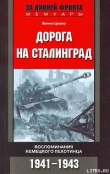
Текст книги "Rommel's Deutsches Afrika Korps 1941-1943"
Автор книги: Автор Неизвестен
Жанры:
История
,сообщить о нарушении
Текущая страница: 10 (всего у книги 19 страниц)
Punctually to the minute the Stukas made their entrance and the crash of the explosions of their bombs was hidden by the noise of the artillery barrage. All fire, whether from land or air, was directed upon the south-eastern corner of the town. Under cover of the barrage engineers began to work on lifting mines and then the Africa Corps armour moved forward with the Italian XX Corps on its left both Corps with the same battle order 'Forward to the sea'. By 06.35hrs the barbed wire around one defensive position had been cut away by a unit from 21st Panzer Division and an hour later the 15th Panzer was able to report that they had captured a strong point on their sector of the narrow attacking front. Then, against increasingly heavy British artillery fire, two more positions fell and at 08:30hrs the 15th Panzer Division sent in the first vehicles across a bridge brought forward to span an anti-tank ditch. On 21st Panzer Division's sector German infantry swarmed across the ditches and by 08:50hrs the first tanks of that division had crossed. A break-in had been made, now the situation had to be exploited. British artillery fire and minefields reduced the pace of the advance but could never halt it, and, despite the use of heavy artillery and then of tanks, the Africa Corps forced its way through the British defences; for although Tobruk had a very strong garrison the defences had been run down and it was in no state to stand a new siege.
The Italian Corps had failed in its intent and was still outside the Tobruk perimeter, a situation which resulted in severe flanking fire being poured down upon the German attackers as they moved steadily forward through the maze of defensive positions. The Brescia Division was then brought forward to consolidate the battlefield behind the advancing spearheads. By midday 21st Panzer had reached an important defence point and having sent out groups to clear the ground to the east of the captured box then advanced upon Tobruk harbour. The 15th Panzer, too, had reached the Via Balbia and had turned its guns upon the town and harbour. The Italian Corps still held up outside the perimeter was then brought in behind Africa Corps and ordered to begin to roll up the British front from east to west. The pace of the advance quickened as the perimeter in which the British were imprisoned grew smaller in extent and the defensive positions were no longer able to bring cross-fire to bear upon the attacking Germans. By 17:00hrs 21st Panzer Division
had begun to attack the town – by 18:30hrs the 15th Panzer Division had captured another box against a defence that held out to the last, and by 19:00hrs Fort Pilastrino had fallen. Then the harbour and town was seized together with the town's water supply.
The onset of darkness did not halt the fighting and shortly before midnight 21st Panzer had captured the El Auda area and the pumping station. All through the night detonations rocked the town as the British supply dumps were blown up and thick clouds of black smoke rolled slowly across the desert. The next morning was spent in consolidating the gains made, clearing out the last areas of resistance, and pursuing the British rearguards. No less than 33,000 prisoners were taken and sufficient supplies to nourish the next stage of the Africa Corps' advance. A fortress with a massive garrison, and large masses of supplies, and which had held out for eight months, had fallen within 40 hours. Now the way forward into Egypt was free and Tobruk, the essential harbour was in Axis hands. But then came the blow from Commando Supremo; the advance was to halt so that the forces for Malta might be assembled, and the Corps was not to pass the line Sidi Omar-Halfaya-Sollum. The 90th Light and an infantry battalion had already pushed the advance that far, had reached Bardia, and had halted at Capuzzo which was held by units of 8th Army.
A small comedy of errors was then played out in Tobruk. The British officer, who went to offer the surrender of Tobruk, was directed in error to the headquarters of the Italian Corps commander who then passed him on to the German commander. But this error was enough for Mussolini to proclaim to the Italian people that the offer had been made to the Italians, by implication that the Army had borne the greatest burden in the capture of Tobruk. To trump this Hitler promoted Rommel to the rank of field marshal whereupon Mussolini trumped his partner's ace and first Cavallero and later Bastico both received their marshal's staff. The battle for the Gazala position had ended with the capture of Tobruk and the balance sheet showed that no less than 45,000 British soldiers had been taken prisoner, five of them generals. Nearly 1000 British tanks had been either destroyed or captured, and more than 400 guns had been taken. But this was not the end as Rommel pointed out in an 'Army Order of the Day' 'Now we have the chance to destroy the enemy absolutely. In the coming days I shall make fresh demands upon you in order that we reach our objective.'
Battle of Alam Halfa – First Alamein
The battle for Marmarica was over and on 22 June Rommel, Bastico, and Kesselring discussed the idea of a continued advance. Bastico demanded a halt in accordance with orders but Rommel, pointing to the materials which had been taken in Tobruk, said that the 8th Army was on the run and that with these supplies the pursuit could be continued. The agreement of the Axis leaders was obtained; the attack could proceed. One group thrust forward to capture Sollum and the Halfaya areas while 15th and 21st Panzer Divisions swept eastwards towards Egypt, with the Italian Motorised Corps left far behind in the tempo of their advance. The pace was exhilarating for all ranks knew that speed was of the essence and despite the weeks that they had spent in battle without rest or respite, it was with high hopes that the battle-hardened warriors of Africa Corps drove towards the wire. They crossed it at 20.30hrs but the advance was not halted and the pursuit was maintained throughout the hours of darkness.
Shortly after first light on 24 June the report was received that the British were withdrawing and the speed was increased to cut them off. The pace of the pursuit had been so furious and the columns so widespread that the supply trucks were again having difficulty in locating the columns. Water began to run short for the ration had been cut so that the vehicles could carry more petrol to bring the advance forward. Even so 21st Panzer Division's tank regiment ran out of fuel and to prevent loss of contact with the 8th Army rearguard, petrol was siphoned from other vehicles to keep the point unit mobile. The speed of the advance, the long periods without servicing, the high temperatures, and the appalling going had so affected the panzers that the drop-out rate was high and the strength of the Africa Corps dropped to 60 runners. The Italians were in little better shape: Ariete had been reduced to 10 tanks, 15 guns, and 600 Bersaglieri. The Trieste had 4 tanks, 24 guns, and 1500 Infantry.
The 8th Army was withdrawing with all speed to its prepared positions at Alamein and relied heavily upon the Royal Air Force to impede by bombing the Panzer drive. On 26th the fierce and unrelenting air attacks prevented the panzers from refuelling and neither division was able to resume the advance until 09.00hrs; four hours of daylight and campaigning time had been lost. During the following day the British rearguard near Mersa Matruh, attempting to hold back the panzer drive, was broken and in the ensuing scrimmage 90th Light cut the Via Balbia. Auchinleck took over command of 8th Army and Mussolini wired from Rome orders which included the naming of Suez as the first objective of Panzer Army. In a bid to hold the Germans west of Matruh the 1st Armoured flung in a series of attacks but these were beaten back and the British forces lost another 18 of their armoured fighting vehicles. Fighting continued all through the night of 27/28th as groups of British units, by-passed during the advance of the day, tried to fight their way out of encirclement. During the afternoon of 28th, the 21st Panzer Division had captured the high ground south-west of Fuka and then went on to seize the aerodrome and to cut the road. The advance was putting a strain on the Axis armour and the evening vehicle state showed that the Africa Corps had been reduced to only 41 runners. [15]

Mersa Matruh fell on 29th to a thrust by 90th Light and more than 6000 prisoners were taken. With Matruh fallen the advance swept forward towards El Daba and XX Corps followed closely behind the armoured spearhead now approaching close to the Suez Canal.
Less than 2 hours drive from the point unit's position at midnight on 29 June, lay the British fleet base of Alexandria. Only 60 miles separated the African Panzer Army from the objectives for which it had been fighting for over a year but already the ground conditions were deteriorating. East of Mersa Matruh the Libyan plateau is cut by numerous steep-sided and deep wadis and the passable country begins to narrow until at El Alamein it is only 40 or so miles wide. This was a natural barrier for one flank rests on the sea and the other on the impassable sand seas of the Quattara Depression. The only route to Alexandria was across this cut-up, stony desert whose narrow width had been set with strong fortifications and extensive mine-fields. As at Gazala these fortifications were a line of mutually supporting boxes and at Alamein they pivoted around the principal box bearing that name. Into these defences streamed the remnants of 8th Army and, passing through the lines of boxes, held by fresh and untried troops the formations which had been shattered at Gazala and at Knightsbridge halted for breath and within a short time had turned, once again, at bay.
The strengths of both armies was about equal at that time, but the morale of the Panzer Army was decidedly higher than that of 8th Army for the Germans could see before them the successful end to the campaign. Leaving little time for proper planning Rommel decided to make a quick thrust in the hope of penetrating the Alamein line and planned that the heaviest blow would fall in the north while the Italian Motorised Corps carried out a feint attack in the south. A British spoiling attack came in during the afternoon of 30 June under cover of a sand-storm but 21st Panzer struck back and the British armour withdrew.
On 1 July after an all-night drive the Africa Corps was ordered into the attack at first light. Three-quarters of an hour after that time at 06.46hrs, the assault rolled with troops who were desperately tired. Rommel could see before his eyes the glittering prizes of the Middle East and drove his men on. But the British, too, realised that this was the preparation for the final battle and fought with a bitterness that was born of desperation. All through the long July day the fighting swung back and forth; the box at Bir el Schine was taken but 90th Light Division lost all its artillery without making any impression upon the British defenders. Throughout 2 and 3 July the battle continued and into the fight the British flung the Royal Air Force to carry out an intensive, almost continuous, bombardment of the Axis troops. British counter-attacks against the lost box were beaten off with a loss of 30 tanks and in 90th Light Division's sector the advance inched forward against fanatical opposition right to the edge of the British prepared defences. There the attack collapsed through sheer exhaustion and weakness; the strength of 90th Light had been reduced to only 58 officers, 247 non-commissioned officers, and 1023 men.
Rommel swung the emphasis to the central sector dominated by the Ruweisat ridge but in the south the New Zealanders had attacked the Ariete Division which broke and ran, leaving the flank open, and only a vigorous counter-attack by the panzers held the New Zealanders back. The loss of Ariete in the line reduced the strength of the Axis forces to a level at which it was no longer possible for Rommel to continue with the offensive and the assault against the Ruweisat ridge was called off on 4 July. The ensuing pause was used to regroup and to bring forward ammunition, particularly artillery shells and this piece of husbandry proved itself when a British tank force broke through the positions held by 21st Panzer, rolled over an infantry battalion, and had practically thrust through the gun line when it was brought under fire by an army artillery group and driven back with loss. An ammunition column reached the forward positions and these new supplies were able to ensure that for the immediate future the German artillery would be able to reply to British barrages, although on a much more modest scale.
The Littorio and the Ariete Divisions each had 5 tanks, 2 and 1 gun respectively, while the Africa Corps' panzer divisions had a combined total of 50 vehicles. There were only 1500 men in 90th Light's infantry component, the reconnaissance battalions had only 15 machines between them, 20 armoured trucks, and 2 batteries of guns. The Italian X Corps had 11, partly motorised battalions each of 200 men, 30 light, and 5 heavy batteries of guns. Thus, the position at the end of the first week of July was that neither side had the reserves whose commitment would have broken the deadlock. An exhausted British Army which had lost 80,000 men had halted an equally exhausted Axis army along a defensive position, which had been selected by one former commander and prepared by another.
After the necessary regrouping the Panzer Army was ready for action again and the first attacks on 9 July, against the Alamein position, went in from the south. The mine-fields were crossed, the field defences taken by storm, and a penetration of the main defensive area looked possible when a British counter-attack against the Italians on the northern sector tore Sabratha Division apart A battle group from 15th Panzer Division closed the gap but then, on 11th, the 8th Army struck at another Italian division and destroyed two battalions of infantry. There were no reserves to commit and Rommel was forced to send in his batteries of 8.8cm guns to hold the gap until he could mount an assault upon the Australians. This counter-attack drove them back and on the central sector the Ruweisat ridge was, once again, the scene of desperate struggles to gain the high ground. During the following days the battle roared around this narrow strip of desert with the 8th Army selecting weak Italian units and destroying them one by one. On 15 July Brescia was rubbed out; two days later Trento followed Trieste and the British began the first move to roll up the German front from the south. A small sector around the Bir el Schine became the focus of the righting as the 8th Army strove to capture the place and thus divide the Axis forces. A desperate counter-attack restored the situation but this battle of attrition could only end in German defeat unless the supply position was eased.
The appearance of both Kesselring and Cavallero upon the field of battle allowed Rommel the rare opportunity of asking them directly for supplies. Both the senior officers brought promises but no certain information. Berlin had proposed and promised so many things but high seas, strong winds, and any number of excellent reasons were given for the non-arrival of the ships. Rommel was sick at heart and his bitterness was increased at the news of the latest losses, for at the reported rate the time would soon come when the Africa Corps would no longer exist. As well as this fear of impotence was the added worry that Italian units were becoming less and less able to stand the lightest stress. There was no alternative; Rommel called off the attacks and. realising that the British commander would capitalise upon this weakness, made a point of organising personally the defence of the captured sectors. So effective were his efforts that the British probing assaults made on 23 June were flung back with a loss to the 8th Army of 146 of its tanks and 1400 of its men. Both sides now began to prepare for the trials ahead.
A heavy sense of destiny hung over the battlefield during those months of late summer and early autumn 1942. Instinctively, it seemed both sides knew that the clash for which they were preparing would be the one to decide the fate of Africa. If Rommel could revivify his exhausted soldiers and their dilapitated machines, if the magic of his personality could bring them forward once again and this time with sufficient impetus to smash through the Alameir. defences, then the prizes for which he had fought lay within the grasp of his veteran warriors. But if he failed, then he and his armies were condemned tc watch, with a full knowledge of its grim and awful consequences, the 8th Army increase day by day in strength and confidence until one moon-fillec night a roar of guns would beat the drum roll of defeat of Axis hopes in the southern Mediterranean.
Slowly the supplies and reinforcements came into the line and by 1 August 15th Panzer Division numbered 6407 men, 65 panzers, and 36 field guns. The strength of 21st Panzer Division was a little higher with 8996 men, 6S armoured fighting vehicles, and 47 guns. To these two veteran divisions and tc that of 90th Light was added a new formation, 164th Division, which had been garrisoning Crete and which had been sent across in such haste that its 6903 officers and men were without trucks of any sort.
The Italian Corps, too, were gaining strength but slowly, and X Corps had one infantry battalion on establishment for which there were no weapons available. In XX Corps only 4 of the 9 battalions of infantry were motorised and XXI Corps presented an equally depressing picture. Only the Folgore Division, the Italian parachute unit, had a satisfactory establishment of anti-tank battalions – two on establishment and both up to strength.
The losses to the Axis armies from the end of May had been average: 2908 Germans and 1338 Italians were killed or died of wounds; 9260 Germans and 11,457 Italians were wounded, and 4000 Germans went missing against 6000 Italians. The German establishment was short by 484 officers and 11,500 men. It was a depleted army which faced the growing might of Britain and her Empire.
From the German and the Italian High Commands came promises of fuel and supplies to nourish the offensive for, having accepted the need for the attack, they were now demanding action from Panzer Army Africa. Rommel stressed that the 6000 tons of fuel promised by Cavallero must arrive within two days of the promised date, otherwise the offensive would have to be postponed for a month and within that time the British would have grown too strong. The Axis armies were ready for the assault and, given the petrol, the break-through could be accomplished and the battle fought to a successful conclusion. The tanker bringing petrol was torpedoed and as an interim measure Kesselring offered to fly in fuel. A second tanker came in on 30 August and at 22:00hrs on that day the battle opened but with an alteration to Rommel's original plan and one which had more modest objectives. Rommel intended that the main effort of his new assault would be in the south and it was there that he massed the Africa Corps and two Italian divisions. Once the breakthrough had been achieved then the whole southern wing would pivot and drive northwards with the intention of trapping 8th Army in the field and there destroying it. The original plan had foreseen a wider and deeper southern drive.
The keys to the battle were two ridges and it is the more important one, whose name, Alam Haifa, records this battle in British military history. Along the central part of the front was Ruweisat ridge and this dominated the whole of the middle sector. Alam Haifa was about 10 miles to the east of Ruweisat and observation from its summit allowed its occupants to control the course , of the fighting. The six Axis divisions struck at the British forces holding the southern end of the line whose farthest extremity was marked by the Himeimat ridge, a small pimple of ground but one of local tactical importance. Throughout the night of 30 August German mine-clearing teams had gapped the fields and by first light there was a space through which the armour and the infantry might pass. The tanks of the 8th Army, with the Rifle Brigade in support, flung back the first assaults but the army commander's orders were that the British Army was not to allow itself to be pinned down but was to give ground, leading the enemy on to where the armoured might of 8th Army waited on a ground of its own choosing. The pace of the Axis advance slowed against the British holding assaults but the thrust was carried to within 20 miles of Alamein. The Italian XX Corps was still stuck in the mine-fields and could give no help to the German spearhead, while on the central sector 90th Light had struck and forced back the 5th Indian Division's garrison on the Ruweisat ridge. As the armoured wedge of 15th and 21st Panzer Divisions drove northwards the tanks of 4th Armoured and 7th Motor Brigades struck at the flanks from the east while from the west came the flank assaults of 7th Armoured Division. Directly south of Alam Haifa ridge Montgomery had positioned 22nd Armoured Brigade and to support this unit there was the 10th Armoured Division. The .British intention was that every step of the German advance would be contested and to help delay the panzer thrust the Royal Air Force bombed the columns by night and by day.
The fierce fighting knew no break and, indeed, grew in intensity. Generals striving to carry out Rommel's intentions died at the head of their men as they brought them forward for one more charge: Bismarck of 21st Panzer fell and Nehring, commanding Africa Corps, was wounded. Losing men and tanks but slowly gaining ground the Germans beat their way forward and in the moonlit night of 31 August the point units, having reached the 40-kilometre point east of the start line, were ordered to swing out in a wide scything movement. As the panzers were refuelled the Littorio and other Italian divisions came up slowly on to the left flank and 90th Light Division dug in to consolidate the ground which it had won. But the fuel situation was once again desperate for the ships promised by Commando Supremo had been sunk en route. There was no immediate prospect of another ship, the Luftwaffe could not air-transport the amounts of fuel required, and the supplies still available could not reach the battlefield in time. For the last time Rommel regrouped his depleted and exhausted troops in one, final desperate panzer assault but it died and with it died the German hopes in Africa.
The last panzer assault upon the Alam Haifa ridge had failed and now nothing remained but to withdraw the troops back behind the mine-fields and there to establish some sort of bridgehead. In the afternoon of 3 September British reconnaissance patrols reported that three large Axis columns were moving westwards. The New Zealanders, who had borne the brunt of the panzer drive moved forward to cut the mine-field gaps through which the Axis armour would have to pass and thus cut the Africa Corps off. Fierce fighting marked this final stage of the battle but the Germans held the corridors open long enough and completed the withdrawal by 5 September.
Now with the knowledge that each succeeding day would see the British growing stronger, and certain of the fact that the promised supplies would never arrive, Rommel organised his positions to defeat the British thrust when it came, for if Alamein was a good defensive position for the 8th Army then it was a sufficiently good position for him. It was now his task to hold out for as long as possible for there was only the road back.
The medical officer of 21st Panzer Division, writing his report on conditions in the field, remarked that cases of lice infection were being found among the troops and that rodents were making their appearance behind the lines, A later report noted an increase in dysentry cases and, as a result of the men sleeping in the open without cover or rest, there was an increase in other illnesses and diet deficiencies were responsible for the great increase in hepatitis. In order to conserve his thinning ranks Rommel ordered that the strictest camouflage measures be undertaken to hide his precious panzers from air attack. The commander-in-chief threatened to fly over divisional positions to check that his orders were being carried out and this warning was sufficient.
This enforced rest was the first break from battle that the German troops had had since Gazala four months before and not only was the opportunity taken to carry out maintenance on the vehicles and to care for the artillery but refresher courses were run and the army settled down. They would not have been soldiers if they had not grumbled and their complaints were very much those of front line soldiers everywhere. The German troops in Africa felt that they were being neglected by the artistes of the front-line theatres in favour of rear echelon units and the Luftwaffe, who had more comfortable quarters and better food. It was a well-known secret that Luftwaffe planes flew between Africa and Europe bringing back fresh vegetables and delicacies unobtainable in the southern Mediterranean.
In order to pass the time more pleasantly, regimental officers tried to obtain sports gear but found that this would have to be indented for from Italy. Entertainments at regimental level and from regimental sources were organised and the group of comedians from 104th Panzer Grenadier Regiment were very popular. Army reported that there were 12 speakers available who could talk amusingly on many subjects and issued 1200 sets of games among the troops. The 21st Panzer received musical encouragement in the shape of 8 piano accordians and among the visits received by division were the bands of 5th Panzer Regiment and 104th Panzer Grenadier Regiment. Copies of the soldiers' newspapers printed in the Mediterranean theatre of operations – Die Oase, Adler von Hellas, and Kolonie und Heimat -were distributed as well as guides to historic Africa and various books written by divisional officers.
During this period there were certain ceremonies for which there had been no time while on active service. The 5th Panzer Regiment received a certificate for its 500th “kill”, the Panzer Artillery Regiment No 155 for its 80,000th round fired, and the divisional bakery company for its four millionth loaf baked.
Naturally there had been planning at high level and alternatives were drawn up to the main defence plan in the event of a British breakthrough at the south or the north. The growing realisation that Italian troops were now completely unreliable produced the scheme under which the Axis forces were intermingled so that each major Italian formation had a stiffener of German troops either with or near it. For all the fact that they were an unreliable element the amount of shipping space taken by the Italians was out of all proportion for no less than 77,000 men of that army's total strength of 146,000 was engaged in security or in administrative duties and the allocation of space in the convoys was computed upon Italian requirements and not upon the demands of the front line. Thus the ridiculous situation arose in which Italian rear units were up to establishment in trucks while German lorries for fighting units were waiting for space on docks in Italian harbours. Not once during the first seven months of 1942 did the amount of supplies received by the Africa Corps come up to the indent figures and less than 50 per cent of the minimum requirements of 30,000 tons of fuel was received. By adopting the most draconian measures, including cutting the bread ration, the Africa Corps was able to find shipping space to bring in the battle equipment it so desperately needed. One indent for 2400 tons of fuel produced a supply – 100 tons. But not all these shortages were attributable to Italian selfishness. The Royal Navy and the Royal Air Force, had combined to strangle the armies in Africa by cutting off supplies and had had such success in sinkings that the total number of ships available to the Axis forces was 4 fast and 7 slow steamers. Even the fast ships could only make one journey each month and the slow ships had to wait for a convoy.

The despair of the senior officers of Panzer Army was best summed up in the words of Stumme who commanded while Rommel was in Germany, 'We stop one hole only to tear another hole open. Freedom of manoeuvre is for the Army an absolute necessity.' As if to underline the complete misunderstanding of the situation facing Panzer Army which was held by OKH, an order was sent that all men who had served in Africa for longer than a year were to be returned to Germany. Then, the Malta [16] operation having been cancelled, the Ramcke Parachute Brigade, all of them specialists in parachute operations, were put into the line as ordinary infantry.
Throughout the long weeks of waiting British air supremacy kept the Germans in ignorance of the tremendous build-up of 8th Army strength but then came the first night of Alamein. A British force of 177,000 men, 2180 guns, 1110 tanks, and 700 aircraft faced an Axis force of 93,000 men, 1400 guns, 500 tanks, and 700 aircraft. The Panzer Army's 15th Panzer Division had only 3840 men, the 164th Division only 6343, 21st Panzer only 3972. and the 90th Light Division 2827 men. There were 24,173 men in the forward zone, including artillery and the flak division. Also in the front line sectors were 230 panzers with the Africa Corps and 300 with the Italians. There was no mobile reserve because there were neither troops, tanks, nor fuel to provide one.








